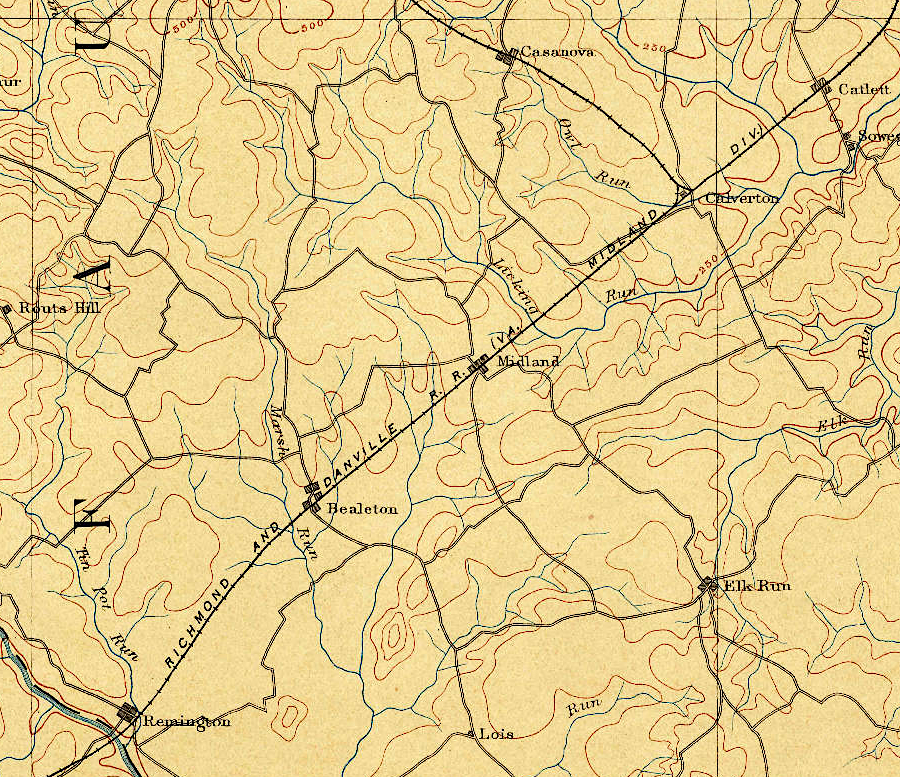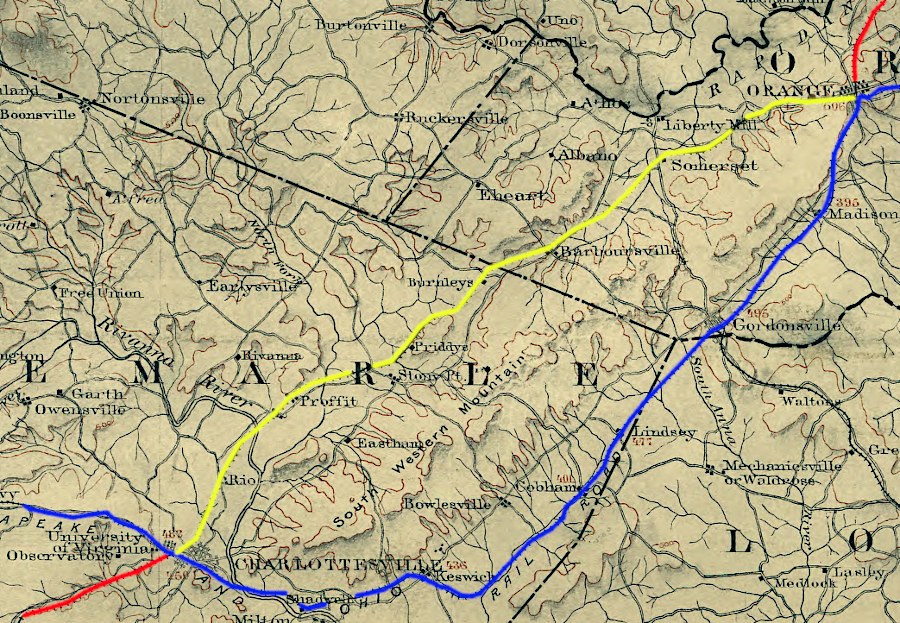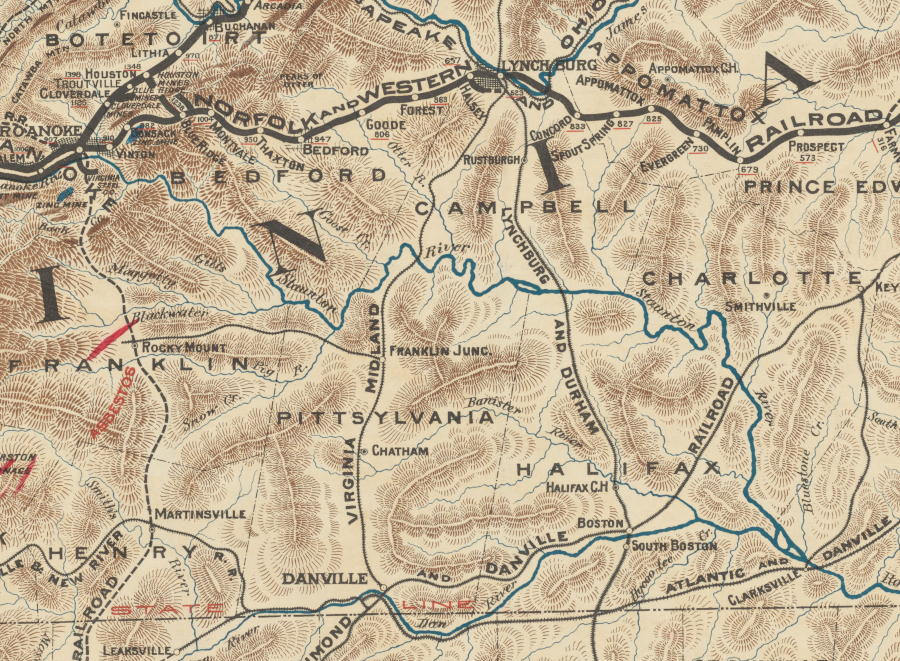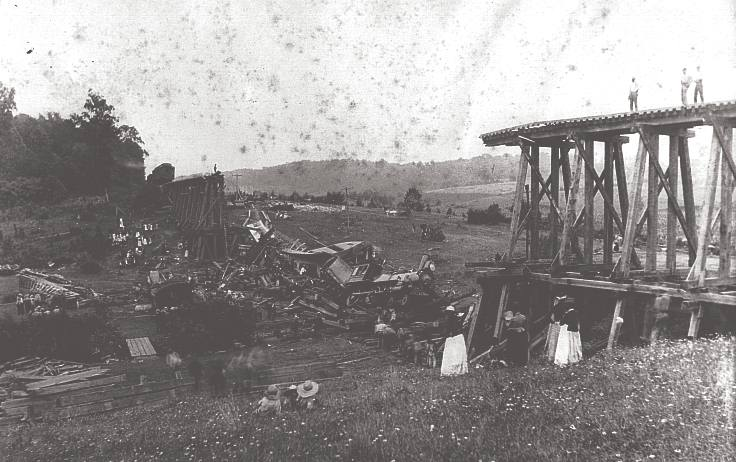
the Richmond and Danville Railroad gained control over the Virginia Midland in 1886
Source: US Geological urvey (USGS), Warrenton VA 1:125,000 scale topographic quadrangle (1894)

the Richmond and Danville Railroad gained control over the Virginia Midland in 1886
Source: US Geological urvey (USGS), Warrenton VA 1:125,000 scale topographic quadrangle (1894)
The Washington City, Virginia Midland & Great Southern Railroad was formed after the Civil War, when the initial investors in railroads could no longer maintain exclusive territories from which they hauled traffic to a single port city. The 405 miles of "Great Southern" track stretched from Alexandria to Danville, combining multiple lines which had struggled to recover from wartime damage and then economic depression.
The railroad was formed in 1873 by combining what had started originally as the Orange & Alexandria, Manassas Gap, and Lynchburg & Danville railroad companies.
Prior to the assemblage, the Orange & Alexandria and Manassas Gap railroads had already been united to form the Orange, Alexandria and Manassas Gap Railroad. When the General Assembly authorized the merger in 1871, it called the new line the Virginia & North Carolina Railroad. Company officials quickly renamed it the Washington City, Virginia Midland & Great Southern Railroad, wich users contracted to "Virginia Midland."
The Baltimore and Ohio (B&O) Railroad controlled the Washington City, Virginia Midland & Great Southern Railroad, after purchasing the Bureau of Public Works shares in the predecessor companies. It was seeking to create a railroad network extended deep into the southern states. As soon as the Washington City, Virginia Midland & Great Southern Railroad was organized, it leased its 51 miles of track between Strasburg and Harrisonburg to the Baltimore and Ohio Railroad. That provided a connection to the Valley Railroad, financed by the B&O to build south from Harrisonburg to Salem.
The railroad was unable to generate enough revenue after the 1873 recession to cover the payments due on its borrowed capital. It went into receivership, but the existing directors were left responsible for managing the corporation.
While being reorganized, and with court approval, the Washington City, Virginia Midland & Great Southern Railroad constructed a branch line in Pittsylvania County to the iron mines on the Pigg River eight miles to the west. Franklin County then funded construction of the Franklin & Pittsylvania Railroad, a narrow gauge line to link the end of the branch to Rocky Mount.
While in receivership, the Washington City, Virginia Midland & Great Southern Railroad also leased the Charlottesville & Rapidan Railroad, which stayed as a separate corporation as it completed track between Orange and Charlottesville in 1880. Having control over a separate line between the two towns eliminated the annual $30,000 in fees which had to be paid to the Chesapeake and Ohio Railroad for trackage rights on its line. Control of the Charlottesville & Rapidan Railroad also allowed the Virginina Midland to pick up and offload freight and passengers from the area between the two cities.

the Washington City, Virginia Midland & Great Southern Railroad (red) leased the Charlottesville & Rapidan Railroad (yellow), eliminating need to use the Chesapeake and Ohio Railroad track (blue)
Source: Library of Congress, Map of northern Virginia (1894)
The railroad emerged from receivership at the start of 1881, with the name Virginia Midland Railway.1
The Virginia Midland Railway was leased by the Richmond and Danville Railroad in 1886. That lease was absorbed by the Southern Railway in 1894, when the Richmond and Danville Railroad and Richmond Terminal were reorganized. In 1898, the corporate existence of the Virginia Midland Railway was extinguished and it was folded into the Southern.2

for North Carolina traffic, the Virginia Midland had competition on the east from the Lynchburg and Durham and on the west from the Roanoke and Southern
Source: New York Public Library, Mineral territory tributary to Norfolk and Western Railroad (1890)

nine were killed when Train 52 (The Piedmont Airline) on the Virginia Midland wrecked at the "Fat Nancy" trestle on July 12, 1888
Source: Images of Orange County, Fat Nancy Train Wreck